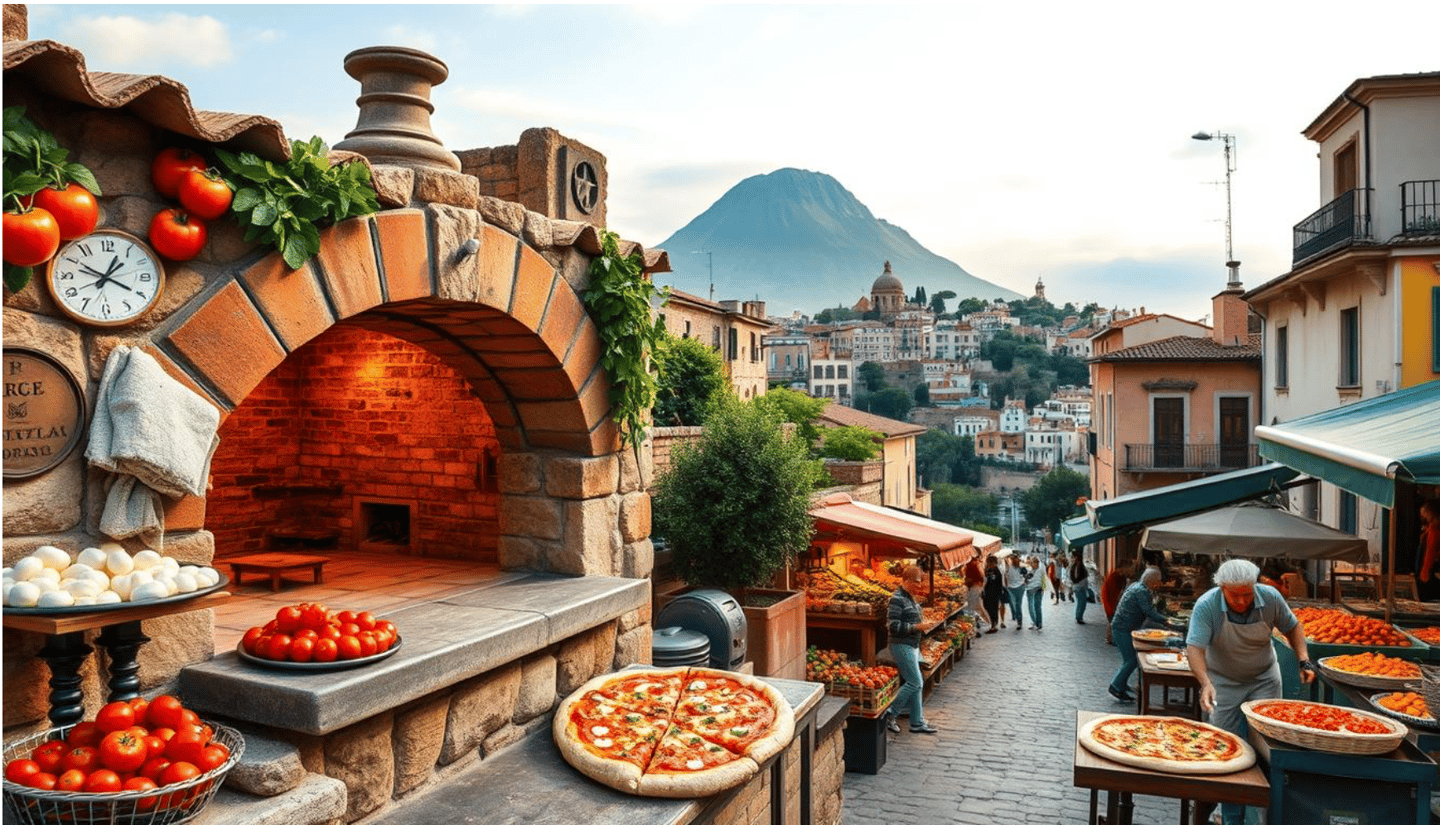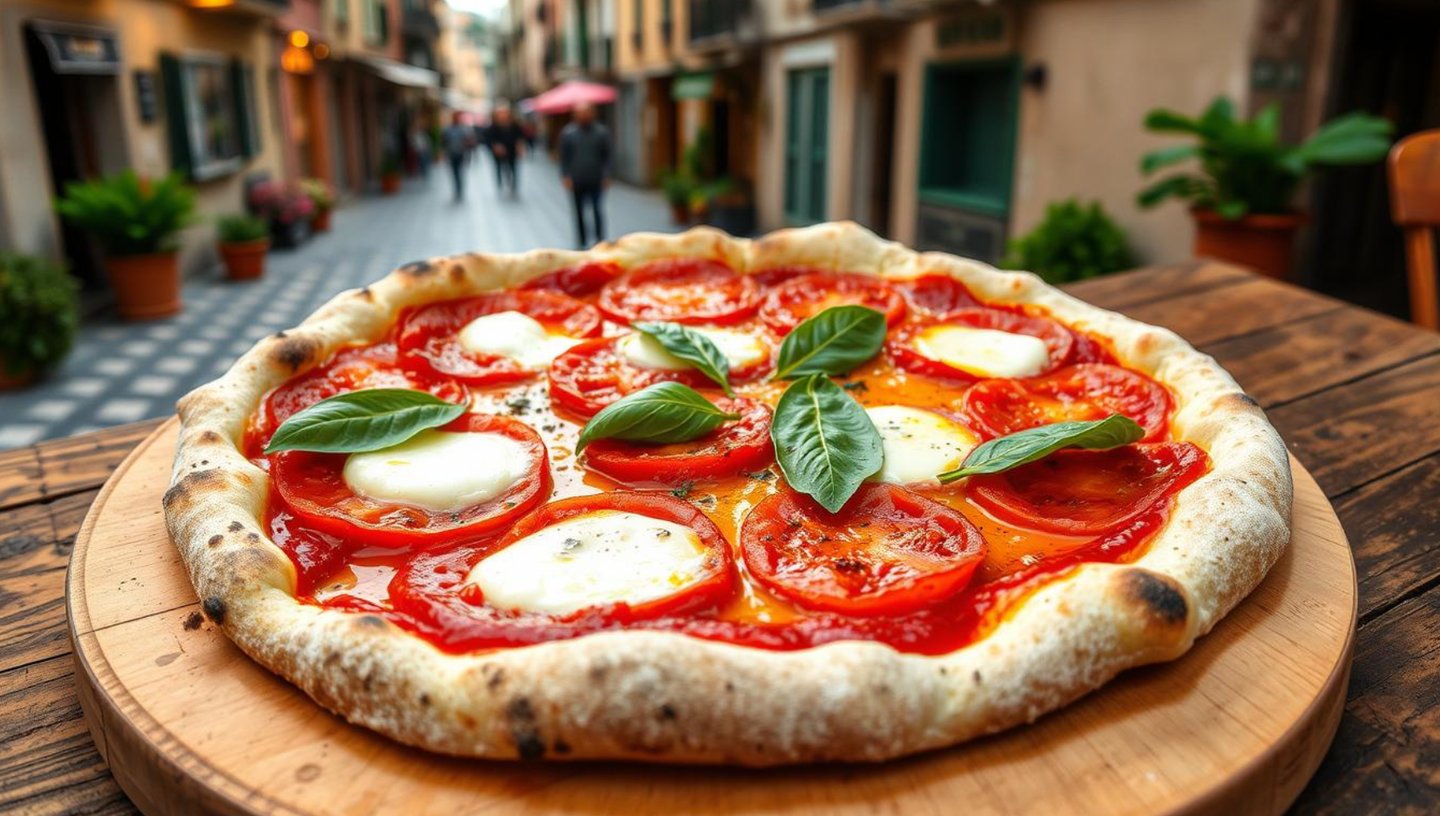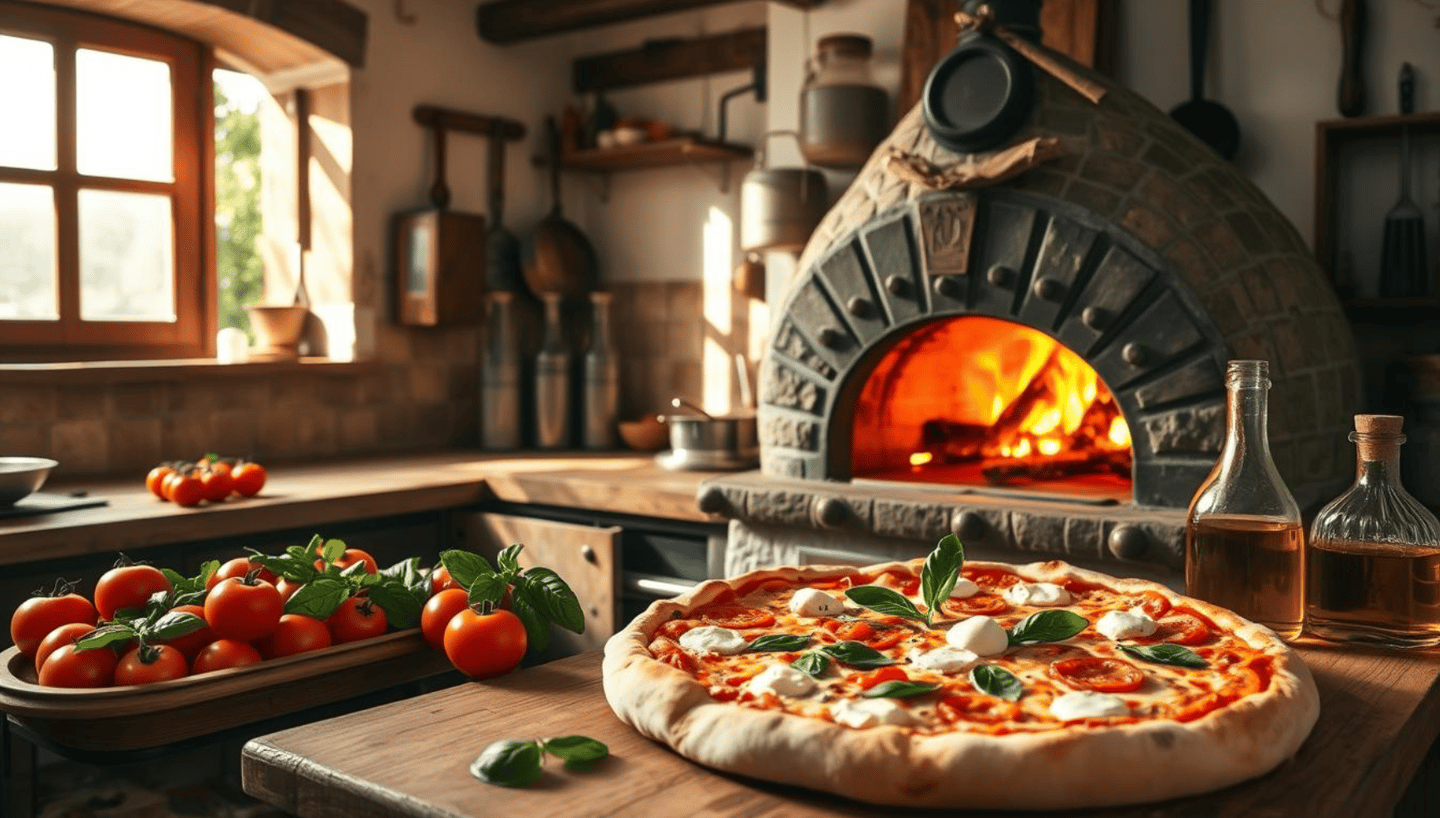Naples, Italy, is where pizza was born, an iconic cornerstone of Italian Cuisine. It's a city with a rich pizza history. After World War II, pizza became famous all over the world. This made it a true culinary icon.


The Origins of Neapolitan Pizza
The story of Neapolitan pizza starts with ancient flatbreads. In the 6th century BC, the Etruscans and Ancient Romans made flatbreads with cheese and dates like today's focaccia. Greeks also made a flatbread called "plakous" with herbs, onions, cheese, and garlic.
Pizza's history goes back to ancient times. . The word "pizza" was first written about in 997 AD in Gaeta, Italy. Later, in the 16th century, tomatoes came to Europe after Columbus' trips. They reached Naples and Sicily, changing pizza forever.
In Naples, the 18th century saw pizzas with tomatoes, garlic, and cheese. Places like L'Antica Pizzeria da Michele and Pizzeria Port'Alba became famous. They helped make Neapolitan pizza what it is today.
The Margherita Pizza: An Iconic Neapolitan Dish
The Margherita pizza origin is a cool story from long ago. It happened in 1889 when Queen Margherita came to Naples. A famous pizza maker, Raffaele Esposito, made a special pizza for her.
He used just three things: tomatoes, mozzarella cheese, and basil. It showed off the Italian flag colors—red, white, and green.
Pizzeria Brandi is where this pizza was first made. It's been open for over 250 years. It shows how loved this pizza is. At Pizzeria Brandi, they make dough for 12 hours. Then, they bake pizzas at 450°C for just 60 seconds. This makes the crust crispy and the cheese melted.
The Margherita pizza origin is tied to Italy's unity in 1861. It honored Queen Margherita and united the Italian people. It showed the Italian flag colors in a tasty way.
Even with some debate, Margherita pizza is still loved today. It's a big part of Italy's food culture.
Now, Margherita pizza is enjoyed all over the world. Its story and recipes have traveled far. They inspire pizza makers everywhere, thanks to Raffaele Esposito’s creation during the Queen Margherita visit to Naples.


The story of pizza in Naples and how it spread across the world
By the early 1800s, Naples was a big place for pizza. It had 54 pizzerias in 1807.
The global popularity of pizza started in the late 1800s and early 1900s. Italian immigrants brought pizza to the United States. There, it became a favorite dish. Italian pizzerias in the U.S. changed pizza to fit local tastes. This led to many international pizza styles.
Pizza chains like Domino's and Pizza Hut grew in the mid-1900s. They made pizza popular all over the world. These chains helped spread pizza far and wide.
Even with new styles, traditional Neapolitan pizza's influence remains strong. It's the base for many international pizza styles.
For those wanting to learn traditional Neapolitan pizza making, the "Associazione Verace Pizza Napoletana" was founded in 1984. It sets rules to keep the art real. This helps true artisans stand out from others, even in New York and New Zealand.
Neapolitan pizza uses authentic ingredients for its flavor. San Marzano tomatoes and Mozzarella di Bufala are key. They come from Campania, Italy. San Marzano tomatoes are sweet and thick. Mozzarella di Bufala adds a creamy, tangy layer. The dough is made with Type "00" flour. It's fine and has high protein. This makes the dough tender and chewy. The dough needs 55-62% water to be right. Wood-fired ovens bake it over 450°C. This gives the pizza a charred crust and smoky flavor.
Today, pizza is loved by people everywhere. It has kept its old charm while also getting new twists. This shows how Italian immigrants and their traditions have shaped pizza's journey.
The Art of Traditional Pizza Making
The art of traditional pizza making has been perfected over centuries, especially in Naples. About 3,000 pizzaiuoli in Naples' Campania Region work hard to make real Neapolitan pizza. UNESCO even calls it an "intangible heritage" treasure.
Below is the method to make it as per the regulations defined by Associazione Verace Pizza Napoletana
Shape and Texture: A true Neapolitan pizza should be round, about 35 cm across, with a soft, raised crust called the “cornicione.” It’s slightly puffy, golden, and never burnt.
Dough Ingredients (for 1 liter of water):
Water: 1 liter
Salt: 40-60 grams
Yeast (depending on humidity): Fresh yeast (0.1-3 grams) or dry yeast (one-third the amount of fresh yeast)
Flour: 1,600-1,800 grams (this varies based on how much the flour absorbs)
Preparing the Dough: Start by mixing the water, salt, and a small amount of flour, followed by the yeast, and gradually add the rest of the flour. Be sure not to let the salt and yeast directly touch for long, as salt can damage the yeast.
Fermentation and Maturation: Once the dough is smooth, cover it with a damp cloth and let it rest. When it’s ready, shape it by hand into portions of 200-280 grams, then let it sit and rise for 8 to 24 hours. This gives it a wonderful texture and flavor.
Forming the Base: Use your fingers to gently stretch each dough ball from the center outwards, forming a thin, round base about 0.25 cm thick.
Toppings:
Use hand-crushed peeled tomatoes or sliced fresh tomatoes as the base.
Add evenly spread pieces of buffalo mozzarella or fior di latte cheese.
Sprinkle a little grated cheese if you’d like, then top with fresh basil leaves.
Finish with a drizzle of extra-virgin olive oil in a spiral motion.
Baking: Bake the pizza in a wood-fired oven preheated to around 430-480°C. It only takes about 60-90 seconds to cook, and the result is an evenly baked, delicious pizza with that classic Neapolitan taste.
And there you have it—an authentic Neapolitan pizza.
This method has been passed down for generations. It shows the true spirit of traditional pizza techniques and artisanal pizza methods


Pizza's Evolution in American Culture
Pizza in America has changed a lot. It started as a special dish from Italy. Gennaro Lombardi opened the first pizzeria in New York City in 1905. This was the start of a big change in food.
The pizza industry grew fast in the U.S. Big names like Domino's, Pizza Hut, and Papa John's came up. They made pizza easy to get and fun to eat.
There are many pizza styles in America. New York-style pizza is famous for its big, thin slices. Chicago's deep-dish pizza is thick and full of toppings. Detroit's square pizza is crispy and soft inside.
Now, pizzas have many toppings. You can find everything from pepperoni to buffalo chicken. This shows how American food loves to try new things.
Today, there are many small pizzerias too. They use special ingredients and old ways of making pizza. This keeps pizza exciting and true to its roots.
Pizza Culture in Different Countries
Pizza is loved all over the world. It shows how different cultures enjoy this dish. Each place adds its own special touch, making a colorful mix of pizza styles.
In Japan, pizza gets creative with squid, mayonnaise, and sushi toppings.
India makes pizza spicy with tandoori chicken, paneer, and spices.
Turkey has a special pizza with lamb and peynir cheese. It's a tasty treat.
Iceland puts bananas on pizza. It's a sweet and savory mix.
Italy stays true to its pizza roots with classics like margherita. But, it also has its own special pizzas.
In Curaçao, they like Gouda cheese on pizza.
Brazil puts hardboiled eggs on theirs
These changes make pizza even more special worldwide. They show how pizza culture in different countries come from local tastes. Pizza brings people together, letting them enjoy their own food traditions.
The Resurgence of Artisanal Pizzaiolos
The world of food has changed a lot with the artisanal pizza trend. It has made people love quality and old ways in pizza making. Now, pizza is seen as a fancy treat, loved by many.
Today's pizza makers use old techniques to make pizza special again. They use slow dough making, hand-stretching, and wood-fired ovens. This makes their pizzas taste and feel different from others.
More and more people want to try these special pizzas. Food critics and fans are excited about this change. They say it has made pizza a true art form, not just fast food.
Impact of Digital Age on Pizza Industry
The pizza industry has changed a lot with the digital age. Online pizza ordering has made it easier for people to get their favorite pizzas. In the United States, people eat a lot of pizza, with three billion slices sold every year.
Pizza apps have also changed how we order pizza. Now, you can customize your order and track your delivery. Companies like Domino's and Pizza Hut use these apps to please their customers.
Digital marketing is key for pizza places. They use social media and email to reach more people. This helps them show off their brand and keep customers coming back.
Also, pizza places use data to understand what customers like. This helps them make pizzas that people want. This way, pizza is more available and keeps getting better.
As online ordering and apps grow, pizza places will get better at serving customers. Mixing old pizza-making ways with new tech will lead to a bright future for pizza.
The Role of Neapolitan Pizza in Pop Culture
Neapolitan pizza is a big deal in pop culture. It's more than just food; it's in movies, TV, and music. This shows how pizza, especially Neapolitan, is in our minds.
In the 1989 film "Do the Right Thing," pizza shows community tensions. The 1990 film "Teenage Mutant Ninja Turtles" made pizza a key part of the turtles' story. These examples show how pizza adds depth to stories.
Pizza also has a special place in music. Songs like "That's Amore" by Dean Martin mention pizza. Pop stars like Ariana Grande use pizza in their videos. This shows pizza's wide appeal and the bond it creates.
Pizza also means comfort and togetherness. Sharing a pizza is like spending time with family. It brings people together, no matter where they're from.
Neapolitan pizza is also known for its history. UNESCO recognized it in 2017. Places like Pizzeria Da Michele and Starita in Naples show its cultural value. Pizzeria Da Michele has been serving quality pizzas since 1870.
Pizza's influence in movies and music is huge. It adds to the story, making moments we remember. Pizza, especially Neapolitan, brings joy to people everywhere.
Conclusion
Pizza started in Naples and now it's loved worldwide. In the U.S., people eat a lot of pizza, about 350 slices every second. It comes in many flavors to please everyone. From Margherita to kimchi-topped, pizza's charm never fades.
Pizza has broken many world records. The most expensive pizza, Luis XIII, costs $12,000. The longest pizza was over 1.8 miles long in South Africa. Pizza Month in October in the U.S. shows how much people love pizza.
New pizza styles keep coming, like Chicago deep-dish and California gourmet. Although some might say that these are not pizza but pies, but to each their own. This basically shows pizza's endless appeal.
The pizza world is always changing. Now, we have gluten-free and vegan pizzas. There are even breakfast and dessert pizzas.
This shows pizza will keep being loved for a long time. Its ability to adapt makes it a favorite for many. Pizza's future looks very bright.


